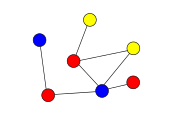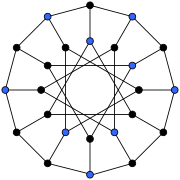Selected topics in finite mathematics/Graph coloring
Appearance
Objectives
[edit | edit source]To color all the vertices where no adjacent vertex is alike, use the least amount of colors possibles
Details
[edit | edit source]vertex coloring graph where no adjacent vertices are similar, two coloring a graph that you only use 2 colors, and three coloring a graph that you only use 3 colors
Examples
[edit | edit source]- The graphs in figure E1-E5 have been colored with three colors. Note in particular that no two adjacent vertices share the same color.
Nonexamples
[edit | edit source]- Neither of the graphs in figures N1 nor N2 are valid colorings because some adjacent vertices use the same color. That is, two vertices that share an edge have the same color.
FAQ
[edit | edit source]Homework
[edit | edit source]- Color the graph in figure H1 with as few colors as possible.
- Color the graph in figure H2 with as few colors as possible.
- Color the graph in figure H3 with as few colors as possible.
- Color the graph in figure H4 with as few colors as possible.
- Color the graph in figure H5 with as few colors as possible.
Homework Solutions
[edit | edit source]2. 5 colors must be used because each vertex is connected to all of the surrounding vertices












